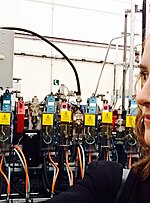Daresbury Hall
Country houses in CheshireGeorgian architecture in CheshireGrade II* listed buildings in CheshireHouses completed in 1759Structures on the Heritage at Risk register

Daresbury Hall is a former Georgian country house in the village of Daresbury, Cheshire, England. It was built in 1759 for George Heron. The house is recorded in the National Heritage List for England as a designated Grade II* listed building. The mansion was badly damaged by fire in 2016.
Excerpt from the Wikipedia article Daresbury Hall (License: CC BY-SA 3.0, Authors, Images).Daresbury Hall
Daresbury Lane,
Geographical coordinates (GPS) Address Nearby Places Show on map
Geographical coordinates (GPS)
| Latitude | Longitude |
|---|---|
| N 53.33798 ° | E -2.62575 ° |
Address
Daresbury Lane
Daresbury Lane
WA4 4AF
England, United Kingdom
Open on Google Maps







